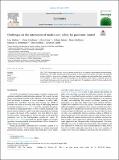Files in this item
Challenges on the interaction of models and policy for pandemic control
Item metadata
| dc.contributor.author | Hadley, Liza | |
| dc.contributor.author | Challenor, Peter | |
| dc.contributor.author | Dent, Chris | |
| dc.contributor.author | Isham, Valerie | |
| dc.contributor.author | Mollison, Denis | |
| dc.contributor.author | Robertson, Duncan A. | |
| dc.contributor.author | Swallow, Ben | |
| dc.contributor.author | Webb, Cerian R. | |
| dc.date.accessioned | 2022-09-28T11:30:28Z | |
| dc.date.available | 2022-09-28T11:30:28Z | |
| dc.date.issued | 2021-12-01 | |
| dc.identifier | 281141130 | |
| dc.identifier | 7dba1d3a-a863-4022-95be-1ba9c5ee0f7e | |
| dc.identifier | 000703684000007 | |
| dc.identifier | 85114810839 | |
| dc.identifier.citation | Hadley , L , Challenor , P , Dent , C , Isham , V , Mollison , D , Robertson , D A , Swallow , B & Webb , C R 2021 , ' Challenges on the interaction of models and policy for pandemic control ' , Epidemics , vol. 37 , 100499 . https://doi.org/10.1016/j.epidem.2021.100499 | en |
| dc.identifier.issn | 1755-4365 | |
| dc.identifier.other | ORCID: /0000-0002-4042-2772/work/118411698 | |
| dc.identifier.other | ORCID: /0000-0002-0227-2160/work/118411964 | |
| dc.identifier.other | PubMedCentral: PMC8404384 | |
| dc.identifier.uri | https://hdl.handle.net/10023/26088 | |
| dc.description | Funding: The authors would like to thank the Isaac Newton Institute for Mathematical Sciences, Cambridge, for support during the Infectious Dynamics of Pandemics programme where work on this paper was undertaken. This work was supported by EPSRC grant no. EP/R014604/1. L.H. is supported by the Wellcome Trust (block grant no. RG92770). C.D. acknowledges the University of Edinburgh’s Data Driven Innovation Programme under Scottish Funding Council support, the Alan Turing Institute sponsored ‘Managing Uncertainty in Government Modelling’ project, and EPSRC (grant no. EP/P001173/1). B.S. acknowledges the Scottish Covid-19 Response Consortium. | en |
| dc.description.abstract | The COVID-19 pandemic has seen infectious disease modelling at the forefront of government decision-making. Models have been widely used throughout the pandemic to estimate pathogen spread and explore the potential impact of different intervention strategies. Infectious disease modellers and policymakers have worked effectively together, but there are many avenues for progress on this interface. In this paper, we identify and discuss seven broad challenges on the interaction of models and policy for pandemic control. We then conclude with suggestions and recommendations for the future. | |
| dc.format.extent | 9 | |
| dc.format.extent | 966893 | |
| dc.language.iso | eng | |
| dc.relation.ispartof | Epidemics | en |
| dc.subject | Modelling | en |
| dc.subject | Policy | en |
| dc.subject | Communication | en |
| dc.subject | Cooperation | en |
| dc.subject | Pandemic | en |
| dc.subject | RA0421 Public health. Hygiene. Preventive Medicine | en |
| dc.subject | QA Mathematics | en |
| dc.subject | T-NDAS | en |
| dc.subject | SDG 3 - Good Health and Well-being | en |
| dc.subject | MCC | en |
| dc.subject.lcc | RA0421 | en |
| dc.subject.lcc | QA | en |
| dc.title | Challenges on the interaction of models and policy for pandemic control | en |
| dc.type | Journal article | en |
| dc.contributor.institution | University of St Andrews. School of Mathematics and Statistics | en |
| dc.contributor.institution | University of St Andrews. Centre for Research into Ecological & Environmental Modelling | en |
| dc.identifier.doi | 10.1016/j.epidem.2021.100499 | |
| dc.description.status | Peer reviewed | en |
This item appears in the following Collection(s)
Items in the St Andrews Research Repository are protected by copyright, with all rights reserved, unless otherwise indicated.

